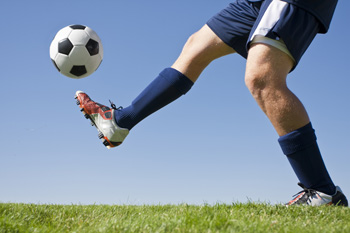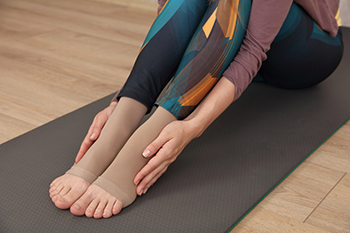Items filtered by date: October 2023
Soccer and Foot and Ankle Injuries

Soccer is a physically demanding sport where foot and ankle injuries are prevalent. Three common injuries in soccer are plantar fasciitis, ankle sprains, and Achilles tendonitis. Plantar fasciitis is the inflammation of the plantar fascia, a tissue connecting the heel to the ball of the foot. It causes pain on the heel and along the arch of the foot and may result from playing on hard surfaces or due to anatomical factors like flat feet or weak muscles. Ankle sprains occur when the ankle ligaments are overstretched or torn. Symptoms can include pain, bruising, and swelling. These sprains are often caused by awkward landings or playing on uneven surfaces. Achilles tendonitis involves inflammation or rupture of the Achilles tendon, causing mild aches or stiffness in the leg. It can be triggered by a sudden change in exercise intensity or from wearing inappropriate footwear. If you or your child has an injured foot or ankle from playing soccer, it is suggested that you make an appointment with a podiatrist for a proper diagnosis, and treatment, in addition to learning about preventative measures that can be taken to make you more resilient against such injuries.
Ankle and foot injuries are common among athletes and in many sports. They can be caused by several problems and may be potentially serious. If you are feeling pain or think you were injured in a sporting event or when exercising, consult with Jordan S. Steinberg, DPM from Florham Park Podiatry . Our doctor will assess your condition and provide you with quality foot and ankle treatment.
Common Injuries
The most common injuries that occur in sporting activities include:
- Achilles Tendonitis
- Achilles Tendon Rupture
- Ankle Sprains
- Broken Foot
- Plantar Fasciitis
- Stress Fractures
- Turf Toe
Symptoms
Symptoms vary depending upon the injury and in some cases, there may be no symptoms at all. However, in most cases, some form of symptom is experienced. Pain, aching, burning, bruising, tenderness, tightness or stiffness, sensation loss, difficulty moving, and swelling are the most common symptoms.
Treatment
Just as symptoms vary depending upon the injury, so do treatment options. A common treatment method is known as the RICE method. This method involves rest, applying ice, compression and elevating the afflicted foot or ankle. If the injury appears to be more serious, surgery might be required, such as arthroscopic or reconstructive surgery. Lastly, rehabilitation or therapy might be needed to gain full functionality in the afflicted area. Any discomfort experienced by an athlete must be evaluated by a licensed, reputable medical professional.
If you have any questions, please feel free to contact our office located in Florham Park, NJ . We offer the newest diagnostic and treatment technologies for all your foot care needs.
Pain in Your Feet May Indicate Tarsal Tunnel Syndrome

Tarsal tunnel syndrome, or TTS, is a painful condition affecting the feet. It is similar to carpal tunnel syndrome but occurs in the ankle, specifically in the tarsal tunnel. This is defined as a narrow passageway on the inner side of your ankle enclosed by bone and a fibrous band. TTS results from compression or pressure on the tibial nerve, which runs through this confined space. There are specific risk factors that may lead to this condition. These can include an ankle injury, standing for extended periods, or participating in athletic activities. The tibial nerve is responsible for providing sensation to the bottom of your foot and controlling some of the muscles in your calf. When the tibial nerve becomes compressed due to injury, inflammation, or an underlying medical condition, it can lead to a range of distressing symptoms, including tingling, burning pain, and numbness in the foot. Understanding the complexities of tarsal tunnel syndrome is crucial for timely diagnosis and effective management, which often involves rest and in some cases, surgical intervention. If you have any form of ankle pain, it is suggested that you consult a podiatrist who can provide the best course of treatment.
Tarsal tunnel syndrome can be very uncomfortable to live with. If you are experiencing tarsal tunnel syndrome, contact Jordan S. Steinberg, DPM of Florham Park Podiatry . Our doctor can provide the care you need to keep you pain-free and on your feet.
Tarsal Tunnel Syndrome
Tarsal tunnel syndrome, which can also be called tibial nerve dysfunction, is an uncommon condition of misfiring peripheral nerves in the foot. The tibial nerve is the peripheral nerve in the leg responsible for sensation and movement of the foot and calf muscles. In tarsal tunnel syndrome, the tibial nerve is damaged, causing problems with movement and feeling in the foot of the affected leg.
Common Cause of Tarsal Tunnel Syndrome
- Involves pressure or an injury, direct pressure on the tibial nerve for an extended period of time, sometimes caused by other body structures close by or near the knee.
- Diseases that damage nerves, including diabetes, may cause tarsal tunnel syndrome.
- At times, tarsal tunnel syndrome can appear without an obvious cause in some cases.
The Effects of Tarsal Tunnel Syndrome
- Different sensations, an afflicted person may experience pain, tingling, burning or other unusual sensations in the foot of the affected leg.
- The foot muscles, toes and ankle become weaker, and curling your toes or flexing your foot can become difficult.
- If condition worsens, infections and ulcers may develop on the foot that is experiencing the syndrome.
A physical exam of the leg can help identify the presence of tarsal tunnel syndrome. Medical tests, such as a nerve biopsy, are also used to diagnose the condition. Patients may receive physical therapy and prescriptive medication. In extreme cases, some may require surgery.
If you have any questions please feel free to contact our office located in Florham Park, NJ . We offer the newest diagnostic and treatment technologies for all your foot and ankle needs.
Accessory Navicular Syndrome

Accessory navicular syndrome is a foot condition where an extra piece of bone, called an accessory navicular, forms near the navicular bone in the foot. This extra bone can cause pain and discomfort, especially when it rubs against shoes or gets irritated due to physical activity. This condition is believed to be related to genetic factors. Treatment for this condition typically begins with conservative measures, such as rest, immobilization, use of orthotics, exercise, and taking anti-inflammatory medication. If conservative treatments do not provide relief, or if the condition is severe, surgical intervention may be considered. Surgery typically involves removing the accessory navicular bone and repairing the nearby tendon. If you think you may have this syndrome, it is suggested that you make an appointment with a podiatrist for a proper diagnosis, evaluation of the severity of your problem, and treatment options.
Some foot conditions may require additional professional care. If you have any concerns, contact Jordan S. Steinberg, DPM of Florham Park Podiatry . Our doctor can provide the care you need to keep you pain-free and on your feet.
Rare Foot Conditions
The majority of foot conditions are common and can be treated by a podiatrist. Standard diagnostic procedures are generally used to identify specific conditions and treatment can be rendered. A podiatrist also treats rare foot conditions which can be difficult to diagnose and may need extra attention and care.
There are many rare foot conditions that can affect children. Some of these can include:
- Freiberg’s disease
- Kohler’s disease
- Maffucci syndrome
Freiberg’s disease - This can be seen as a deterioration and flattening of a metatarsal bone that exists in the ball of the foot. It typically affects pre-teen and teenage girls, but can affect anyone at any age. Symptoms that can accompany this can be swelling, stiffness, and the patient may limp.
Kohler’s disease - This often targets the bone in the arch of the foot and affects younger boys. It can lead to an interruption of the blood supply which ultimately can lead to bone deterioration. The patient may limp or experience tenderness, swelling, and redness.
Maffucci syndrome - This affects the long bones in a child’s foot leading to the development of abnormal bone lesions. They are benign growths and typically develop in early childhood and the bones may be susceptible to breaking.
A podiatrist can properly diagnose and treat all types of rare foot conditions. If your child is affected by any of these symptoms or conditions, please don’t hesitate to call our office so the correct treatment method can begin.
If you have any questions please feel free to contact our office located in Florham Park, NJ . We offer the newest diagnostic tools and technology to treat your foot and ankle needs.
When to Worry About Flat Feet in Children

Flat feet in children might cause concern, but few cases require immediate attention. Still, it is important to be aware of when to investigate your child’s flat feet to ensure their foot health. First, it’s good to remember that babies are born with flat feet, but their arches usually normalize as the child ages, and bones in the foot form. But if your child experiences foot pain, it's a clear sign that a closer look is needed. Additionally, if you notice differences between their left and right feet, or if their feet appear to be getting flatter as the child grows, it may be time to seek advice from a podiatrist. Flat feet should not hinder a child's gait development or delay them in reaching developmental milestones. If your child experiences unexplained difficulties with walking, running, or participating in sports, it's wise to consult a podiatrist. Lastly, heredity may play a role in your child’s development of flat feet. While flat feet are common in children, it's important to be vigilant and seek professional evaluation when necessary. For more information and an exam, it is suggested that you seek the help of a podiatrist for your child.
The health of a child’s feet is vital to their overall well-being. If you have any questions regarding foot health, contact Jordan S. Steinberg, DPM of Florham Park Podiatry . Our doctor can provide the care you need to keep you pain-free and on your feet.
Tips for Keeping Children's Feet Healthy
- Make sure their shoes fit properly
- Look for any signs of in-toeing or out-toeing
- Check to see if they have Clubfoot (condition that affects your child’s foot and ankle, twisting the heel and toes inward) which is one of the most common nonmajor birth defects.
- Lightly cover your baby’s feet (Tight covers may keep your baby from moving their feet freely, and could prevent normal development)
- Allow your toddler to go shoeless (Shoes can be restricting for a young child’s foot)
- Cut toenails straight across to avoid ingrown toenails
- Keep your child’s foot clean and dry
- Cover cuts and scrapes. Wash any scratches with soap and water and cover them with a bandage until they’ve healed.
If you have any questions, please feel free to contact our office located in Florham Park, NJ . We offer the newest diagnostic and treatment technologies for all your foot care needs.
Magnetic Resonance Imaging for Peripheral Artery Disease

Peripheral artery disease, also known as PAD, is a common circulatory condition that primarily affects the arteries of the legs and feet. It occurs when fatty deposits build up in the arteries, causing them to narrow and reduce blood flow to the limbs. Symptoms of PAD include pain, cramping, and fatigue in the legs and feet, especially during physical activity. If severe, this condition can lead to pain at rest, non-healing wounds or ulcers, and tissue damage or gangrene. Treatment aims at relieving symptoms and preventing complications. While non-invasive imaging tests have been used to assess PAD, recent advancements in MRI techniques have had a significant impact on the diagnosis and understanding of this disease. If you are suffering from peripheral artery disease and have troublesome foot symptoms, it is strongly suggested that you make an appointment with a podiatrist to see if any of the newer advancements in testing can better pinpoint effective treatment for you.
Poor circulation is a serious condition and needs immediate medical attention. If you have any concerns with poor circulation in your feet contact Jordan S. Steinberg, DPM of Florham Park Podiatry . Our doctor will treat your foot and ankle needs.
Poor Circulation in the Feet
Poor blood circulation in the feet and legs is can be caused by peripheral artery disease (PAD), which is the result of a buildup of plaque in the arteries.
Plaque buildup or atherosclerosis results from excess calcium and cholesterol in the bloodstream. This can restrict the amount of blood which can flow through the arteries. Poor blood circulation in the feet and legs are sometimes caused by inflammation in the blood vessels, known as vasculitis.
Causes
Lack of oxygen and oxygen from poor blood circulation restricts muscle growth and development. It can also cause:
- Muscle pain, stiffness, or weakness
- Numbness or cramping in the legs
- Skin discoloration
- Slower nail & hair growth
- Erectile dysfunction
Those who have diabetes or smoke are at greatest risk for poor circulation, as are those who are over 50. If you have poor circulation in the feet and legs it may be caused by PAD and is important to make changes to your lifestyle in order to reduce risk of getting a heart attack or stroke. Exercise and maintaining a healthy lifestyle will dramatically improve conditions.
As always, see a podiatrist as he or she will assist in finding a regimen that suits you. A podiatrist can also prescribe you any needed medication.
If you have any questions please feel free to contact our office located in Florham Park, NJ . We offer the newest diagnostic and treatment technologies for all your foot and ankle needs.
